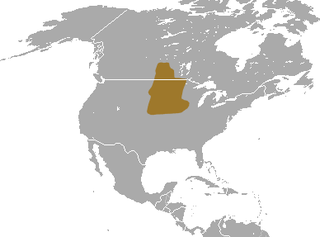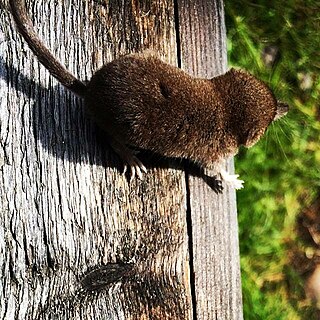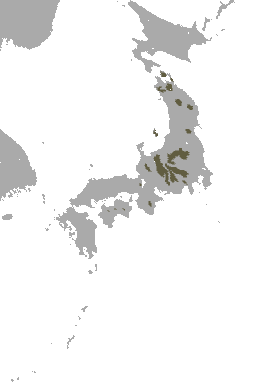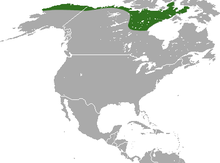
The red-toothed shrews of the subfamily Soricinae are one of three living subfamilies of shrews, along with Crocidurinae and Myosoricinae. In addition, the family contains the extinct subfamilies Limnoecinae, Crocidosoricinae, Allosoricinae and Heterosoricinae. These species are typically found in North America, northern South America, Europe and northern Asia. The enamel of the tips of their teeth is reddish due to iron pigment. The iron deposits serve to harden the enamel and are concentrated in those parts of the teeth most subject to wear. Members of the genera Chimarrogale, Nectogale, Neomys (Nectogalini) and some members of Sorex (Soricini) are known as water shrews, due to having a semi-aquatic lifestyle.

The cinereus shrew or masked shrew is a small shrew found in Alaska, Canada, and the northern United States. This is the most widely distributed shrew in North America, where it is also known as the common shrew.

The American pygmy shrew is a small shrew found in Northern Alaska, Canada, and the northern United States, south through the Appalachian Mountains. It was first discovered in 1831 by naturalist William Cane in Georgian Bay, Parry Sound.

The Arctic shrew, also known as the blackback shrew or saddlebacked shrew, is a medium-sized shrew found in Canada and the northern United States. Separate species status has been proposed for the maritime shrew which is found in New Brunswick and Nova Scotia and had been considered to be a subspecies of the Arctic shrew. The tundra shrew was formerly considered to be a subspecies of the Arctic shrew.

The marsh shrew, also known as the Pacific water shrew, Bendire's water shrew, Bendire's shrew and Jesus shrew is the largest North American member of the genus Sorex. Primarily covered in dark-brown fur, it is found near aquatic habitats along the Pacific coast from southern British Columbia to northern California. With air trapped in its fur for buoyancy, marsh shrews can run for three to five seconds on top of the water. It measures about 16 cm (6.3 in) in length, including a 7-centimetre (2.8 in)-long tail, and weighs an average of 14.5–16 g (0.51–0.56 oz). The marsh shrew's diet consists mainly of invertebrates, which it hunts on land and in the water. They are rare; their populations are thought to be in decline, and they are considered endangered in parts of their range.

The vagrant shrew, also known as the wandering shrew, is a medium-sized North American shrew. At one time, the montane shrew and the Orizaba long-tailed shrew were considered to belong to the same species.

The genus Sorex includes many of the common shrews of Eurasia and North America, and contains at least 142 known species and subspecies. Members of this genus, known as long-tailed shrews, are the only members of the tribe Soricini of the subfamily Soricinae. They have 32 teeth.

The prairie shrew is a small shrew found in the Canadian prairies and midwestern United States. At one time, this species was considered to be a subspecies of the similar cinereus shrew, S. cinereus.

The Gansu shrew is a red-toothed shrew found only in a small part of Gansu province and other adjacent areas of China. With its very limited range, it is sensitive to habitat loss and is listed as a "vulnerable species" in the Chinese Red List, while the IUCN lists it as being "data deficient"

The Eurasian least shrew, also called the lesser pygmy shrew, is the second-smallest mammal by mass after the Etruscan shrew.

Laxmann's shrew, or the masked shrew, is a species of shrew. Its range extends from northern Scandinavia and the Baltic to the Sea of Japan, including Hokkaidō, Sakhalin, and the Korean Peninsula. It favours mountain forests but is sometimes found in tundra and moorland, and also in lowland areas as well. It avoids cultivated land.

The slender shrew is a species of shrew. An adult slender shrew has a weight of 1.5–5.3 g (0.053–0.187 oz) and a body length of 4.7–6.0 cm (1.9–2.4 in), with a tail of 4–5 cm (1.6–2.0 in); this makes it one of the smaller shrews found in its range. It is distributed across northeastern North Korea, Hokkaidō, and the Russian Far East including the Kuril Islands.

The Arizona shrew is a species of shrew native to North America.

The Kamchatka shrew is a species of mammal in the family Soricidae. It is endemic to Russia.

Preble's shrew is a small shrew distributed across the Great Basin of the United States and southern British Columbia in Canada.

The Shinto shrew is a species of shrew of the genus Sorex that lives only on the islands of Japan. It is a mole-like mammal with a pointed snout, very small ears, and a relatively long tail. Like most shrews, it is tiny, has poor eyesight, and a very good sense of hearing and smell which it uses to locate its prey, mainly insects.

The Inyo shrew is a species of shrew found in the western United States. It is light gray and white in color, with a narrow skull and small body size, very similar in appearance to the related dwarf shrew, but paler and not as large. It can be found in many different habitats, from rocky, mountainous regions to wetlands and riparian areas. Not much is known about its behavioral and reproductive habits. While barely studied, their population is believed to be stable and not under any threat.

Trowbridge's shrew is a species of mammal in the family Soricidae. It is found in southern British Columbia in Canada and in Washington, Oregon, and California in the United States.

The southeastern shrew is a species of mammal in the family Soricidae. It is found in the southeastern United States.

The long-tailed shrew or rock shrew is a small shrew found in Atlantic Canada and the Northeastern United States.



















